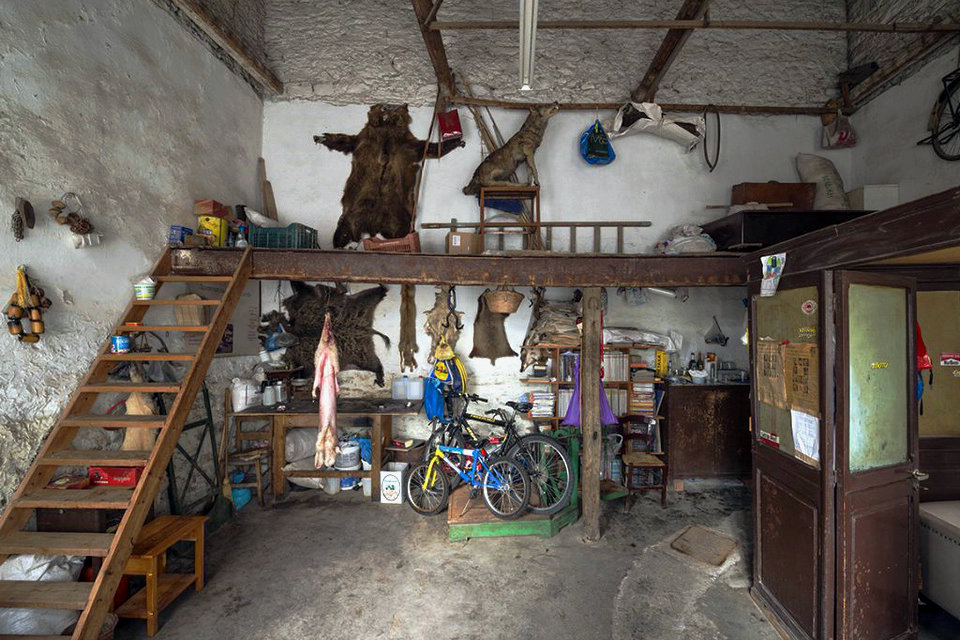Agrimiká – Why look at animals? Greece pavilion, Venice Biennale 2015


In the context of the 56th International Art Exhibition of the Venice Biennale, Outset Greece supports the artist Maria Papadimitriou who will represent Greece with the project AGRIMIKA – Why look at animals?.
The Greek Pavilion immediately manages to create an alienating space, in which the visitor is offered the opportunity to undertake a journey that starts from the real place, the historical one of the exhibition area at the Giardini , to ideally reach the Greek city of Volos. The place in question houses an old-fashioned and discarded animal fur shop that actually exists in the Greek locality, which is reinserted in a profoundly different and distant context.
Maria Papadimitriouís installation is a shop, a vestige of the past, that sells animal hides and leather, transferred from Volos to the central but ìruinedî landscape of Greek pavilion. The AGRIMIKA are animals that coexist with humans, but resist domestication.
A video placed inside the space and the store itself, “transported” by the artist to the pavilion through its installation, reflect and convey to us the personality of the elderly manager, capable of embodying the history and contemporary social and political transformations of the country. The agrimikà to which the artist refers with his work (whose skins are sold in the shop) are animals with a strong personality that populate the human habitat but are opposed to being domesticated.
Just the peculiarity of the animal in question pushes the visitor to think about the opposition between man (predator) and animal (prey) through the elements and sensations that have always characterized the relationship between the two beings, such as attraction and curiosity on the one hand and repulsion and fear on the other. And then the digressions take on additional meanings by connecting the beliefs, fairy tales and ancient myths, always populated by animal creatures in opposition to man, to a contemporary reflection in which the man-animal contrast could represent the features of a humanity drifting, dominated by fear, by the alienation of the foreigner and by the superiority of one people over another.
In this way the shop invites us to enter, making a sort of space-time dive into the past and becomes a metaphor for the contradictions, lacerations and uncertainties of today’s human being, poetically triggering an awareness of the current historical reality and of a necessary change.
We, humans, see in animals the reflection of our own features, behaviors, and manners. This awareness permits separation by contrasting the human with the animalistic. As the beast ends up as embodying the divergence from the human norm, the image of a democratic society is deconstructed, and part of it degraded: rights no longer exist for all and in the same measure.
This presentation of the relationship of humans and animals becomes a contemporary allegory of the dispossessed and the resistant and sparks concerns ranging from politics and history to economics and traditions, ethics and aesthetics, fear of the foreign and the incomprehensible.
Greek pavilion
The Greek pavilion houses Greece’s national representation during the Venice Biennale arts festivals.
Architect M. Papandréou designed the pavilion, which was built between 1933 and 1934. Brenno Del Giudice, who led the Biennale’s Sant’Elena expansion, also collaborated on the project. The pavilion’s simple layout includes a T-shaped hall. Greek and diamond patterns adorn the brickwork, and Greco-Byzantine pointed arches line the portico.
The exhibitions at the pavilion are commissioned by the Hellenic Ministry of Culture and Tourism.
Venice Biennale 2015
The 2015 Art Biennale closes a sort of trilogy that began with the exhibition curated by Bice Curiger in 2011, Illuminations , and continued with the Encyclopedic Palace of Massimiliano Gioni (2013). With All The World’s Futures , La Biennale continues its research on useful references for making aesthetic judgments on contemporary art, a “critical” issue after the end of the avant-garde and “non-art” art.
Through the exhibition curated by Okwui Enwezor, La Biennale returns to observe the relationship between art and the development of human, social and political reality, in the pressing of external forces and phenomena: the ways in which, that is, the tensions of the external world solicit the sensitivities, the vital and expressive energies of the artists, their desires, the motions of the soul (their inner song ).
La Biennale di Venezia was founded in 1895. Paolo Baratta has been its President since 2008, and before that from 1998 to 2001. La Biennale, who stands at the forefront of research and promotion of new contemporary art trends, organizes exhibitions, festivals and researches in all its specific sectors: Arts (1895), Architecture (1980), Cinema (1932), Dance (1999), Music (1930), and Theatre (1934). Its activities are documented at the Historical Archives of Contemporary Arts (ASAC) that recently has been completely renovated.
The relationship with the local community has been strengthened through Educational activities and guided visits, with the participation of a growing number of schools from the Veneto region and beyond. This spreads the creativity on the new generation (3,000 teachers and 30,000 pupils involved in 2014). These activities have been supported by the Venice Chamber of Commerce. A cooperation with Universities and research institutes making special tours and stays at the exhibitions has also been established. In the three years from 2012-2014, 227 universities (79 Italian and 148 international) have joined the Biennale Sessions project.
In all sectors there have been more research and production opportunities addressed to the younger generation of artists, directly in contact with renowned teachers; this has become more systematic and continuous through the international project Biennale College, now running in the Dance, Theatre, Music, and Cinema sections.